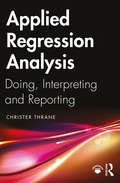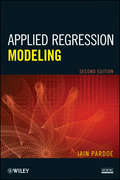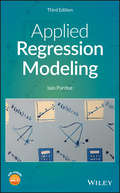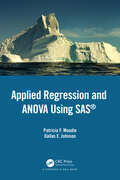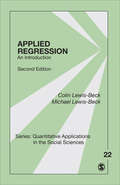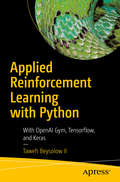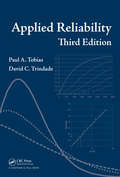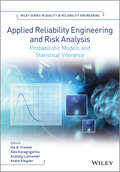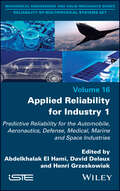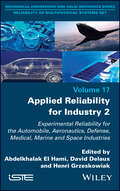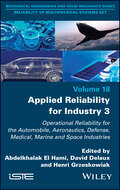- Table View
- List View
Applied Regression Analysis for Business: Tools, Traps and Applications
by Jacek Welc Pedro J. Rodriguez EsquerdoThis book offers hands-on statistical tools for business professionals by focusing on the practical application of a single-equation regression. The authors discuss commonly applied econometric procedures, which are useful in building regression models for economic forecasting and supporting business decisions. A significant part of the book is devoted to traps and pitfalls in implementing regression analysis in real-world scenarios. The book consists of nine chapters, the final two of which are fully devoted to case studies. Today's business environment is characterised by a huge amount of economic data. Making successful business decisions under such data-abundant conditions requires objective analytical tools, which can help to identify and quantify multiple relationships between dozens of economic variables. Single-equation regression analysis, which is discussed in this book, is one such tool. The book offers a valuable guide and is relevant in various areas of economic and business analysis, including marketing, financial and operational management.
Applied Regression Analysis: Doing, Interpreting and Reporting
by Christer ThraneThis book is an introduction to regression analysis, focusing on the practicalities of doing regression analysis on real-life data. Contrary to other textbooks on regression, this book is based on the idea that you do not necessarily need to know much about statistics and mathematics to get a firm grip on regression and perform it to perfection. This non-technical point of departure is complemented by practical examples of real-life data analysis using statistics software such as Stata, R and SPSS. Parts 1 and 2 of the book cover the basics, such as simple linear regression, multiple linear regression, how to interpret the output from statistics programs, significance testing and the key regression assumptions. Part 3 deals with how to practically handle violations of the classical linear regression assumptions, regression modeling for categorical y-variables and instrumental variable (IV) regression. Part 4 puts the various purposes of, or motivations for, regression into the wider context of writing a scholarly report and points to some extensions to related statistical techniques. This book is written primarily for those who need to do regression analysis in practice, and not only to understand how this method works in theory. The book’s accessible approach is recommended for students from across the social sciences.
Applied Regression Modeling
by Iain PardoePraise for the First Edition"The attention to detail is impressive. The book is very well written and the author is extremely careful with his descriptions . . . the examples are wonderful." --The American StatisticianFully revised to reflect the latest methodologies and emerging applications, Applied Regression Modeling, Second Edition continues to highlight the benefits of statistical methods, specifically regression analysis and modeling, for understanding, analyzing, and interpreting multivariate data in business, science, and social science applications.The author utilizes a bounty of real-life examples, case studies, illustrations, and graphics to introduce readers to the world of regression analysis using various software packages, including R, SPSS, Minitab, SAS, JMP, and S-PLUS. In a clear and careful writing style, the book introduces modeling extensions that illustrate more advanced regression techniques, including logistic regression, Poisson regression, discrete choice models, multilevel models, and Bayesian modeling.In addition, the Second Edition features clarification and expansion of challenging topics, such as:Transformations, indicator variables, and interactionTesting model assumptionsNonconstant varianceAutocorrelationVariable selection methodsModel building and graphical interpretationThroughout the book, datasets and examples have been updated and additional problems are included at the end of each chapter, allowing readers to test their comprehension of the presented material. In addition, a related website features the book's datasets, presentation slides, detailed statistical software instructions, and learning resources including additional problems and instructional videos.With an intuitive approach that is not heavy on mathematical detail, Applied Regression Modeling, Second Edition is an excellent book for courses on statistical regression analysis at the upper-undergraduate and graduate level. The book also serves as a valuable resource for professionals and researchers who utilize statistical methods for decision-making in their everyday work.
Applied Regression Modeling: A Business Approach
by Iain PardoeMaster the fundamentals of regression without learning calculus with this one-stop resource The newly and thoroughly revised 3rd Edition of Applied Regression Modeling delivers a concise but comprehensive treatment of the application of statistical regression analysis for those with little or no background in calculus. Accomplished instructor and author Dr. Iain Pardoe has reworked many of the more challenging topics, included learning outcomes and additional end-of-chapter exercises, and added coverage of several brand-new topics including multiple linear regression using matrices. The methods described in the text are clearly illustrated with multi-format datasets available on the book's supplementary website. In addition to a fulsome explanation of foundational regression techniques, the book introduces modeling extensions that illustrate advanced regression strategies, including model building, logistic regression, Poisson regression, discrete choice models, multilevel models, Bayesian modeling, and time series forecasting. Illustrations, graphs, and computer software output appear throughout the book to assist readers in understanding and retaining the more complex content. Applied Regression Modeling covers a wide variety of topics, like: Simple linear regression models, including the least squares criterion, how to evaluate model fit, and estimation/prediction Multiple linear regression, including testing regression parameters, checking model assumptions graphically, and testing model assumptions numerically Regression model building, including predictor and response variable transformations, qualitative predictors, and regression pitfalls Three fully described case studies, including one each on home prices, vehicle fuel efficiency, and pharmaceutical patches Perfect for students of any undergraduate statistics course in which regression analysis is a main focus, Applied Regression Modeling also belongs on the bookshelves of non-statistics graduate students, including MBAs, and for students of vocational, professional, and applied courses like data science and machine learning.
Applied Regression and ANOVA Using SAS
by Dallas E. Johnson Patricia F. MoodieApplied Regression and ANOVA Using SAS® has been written specifically for non-statisticians and applied statisticians who are primarily interested in what their data are revealing. Interpretation of results are key throughout this intermediate-level applied statistics book. The authors introduce each method by discussing its characteristic features, reasons for its use, and its underlying assumptions. They then guide readers in applying each method by suggesting a step-by-step approach while providing annotated SAS programs to implement these steps.Those unfamiliar with SAS software will find this book helpful as SAS programming basics are covered in the first chapter. Subsequent chapters give programming details on a need-to-know basis. Experienced as well as entry-level SAS users will find the book useful in applying linear regression and ANOVA methods, as explanations of SAS statements and options chosen for specific methods are provided.Features:•Statistical concepts presented in words without matrix algebra and calculus•Numerous SAS programs, including examples which require minimum programming effort to produce high resolution publication-ready graphics•Practical advice on interpreting results in light of relatively recent views on threshold p-values, multiple testing, simultaneous confidence intervals, confounding adjustment, bootstrapping, and predictor variable selection•Suggestions of alternative approaches when a method’s ideal inference conditions are unreasonable for one’s dataThis book is invaluable for non-statisticians and applied statisticians who analyze and interpret real-world data. It could be used in a graduate level course for non-statistical disciplines as well as in an applied undergraduate course in statistics or biostatistics.
Applied Regression: An Introduction (Quantitative Applications in the Social Sciences #22)
by Michael S. Lewis-Beck Colin Lewis-BeckKnown for its readability and clarity, this Second Edition of the best-selling Applied Regression provides an accessible introduction to regression analysis for social scientists and other professionals who want to model quantitative data. After covering the basic idea of fitting a straight line to a scatter of data points, the text uses clear language to explain both the mathematics and assumptions behind the simple linear regression model. Authors Colin Lewis-Beck and Michael Lewis-Beck then cover more specialized subjects of regression analysis, such as multiple regression, measures of model fit, analysis of residuals, interaction effects, multicollinearity, and prediction. Throughout the text, graphical and applied examples help explain and demonstrate the power and broad applicability of regression analysis for answering scientific questions.
Applied Regression: An Introduction (Quantitative Applications in the Social Sciences #22)
by Michael S. Lewis-Beck Colin Lewis-BeckKnown for its readability and clarity, this Second Edition of the best-selling Applied Regression provides an accessible introduction to regression analysis for social scientists and other professionals who want to model quantitative data. After covering the basic idea of fitting a straight line to a scatter of data points, the text uses clear language to explain both the mathematics and assumptions behind the simple linear regression model. Authors Colin Lewis-Beck and Michael Lewis-Beck then cover more specialized subjects of regression analysis, such as multiple regression, measures of model fit, analysis of residuals, interaction effects, multicollinearity, and prediction. Throughout the text, graphical and applied examples help explain and demonstrate the power and broad applicability of regression analysis for answering scientific questions.
Applied Regularization Methods for the Social Sciences (Chapman & Hall/CRC Statistics in the Social and Behavioral Sciences)
by Holmes FinchResearchers in the social sciences are faced with complex data sets in which they have relatively small samples and many variables (high dimensional data). Unlike the various technical guides currently on the market, Applied Regularization Methods for the Social Sciences provides and overview of a variety of models alongside clear examples of hands-on application. Each chapter in this book covers a specific application of regularization techniques with a user-friendly technical description, followed by examples that provide a thorough demonstration of the methods in action. Key Features: Description of regularization methods in a user friendly and easy to read manner Inclusion of regularization-based approaches for a variety of statistical analyses commonly used in the social sciences, including both univariate and multivariate models Fully developed extended examples using multiple software packages, including R, SAS, and SPSS Website containing all datasets and software scripts used in the examples Inclusion of both frequentist and Bayesian regularization approaches Application exercises for each chapter that instructors could use in class, and independent researchers could use to practice what they have learned from the book
Applied Rehabilitation Counseling
by T. F. Riggar Dennis R. Maki Arnold W. WolfA comprehensive introduction to the practice of rehabilitation counseling. Appropriate for professionals and those preparing to enter the rehabilitation counseling field.
Applied Reinforcement Learning with Python: With OpenAI Gym, Tensorflow, and Keras
by Taweh Beysolow IIDelve into the world of reinforcement learning algorithms and apply them to different use-cases via Python. This book covers important topics such as policy gradients and Q learning, and utilizes frameworks such as Tensorflow, Keras, and OpenAI Gym. Applied Reinforcement Learning with Python introduces you to the theory behind reinforcement learning (RL) algorithms and the code that will be used to implement them. You will take a guided tour through features of OpenAI Gym, from utilizing standard libraries to creating your own environments, then discover how to frame reinforcement learning problems so you can research, develop, and deploy RL-based solutions. What You'll LearnImplement reinforcement learning with Python Work with AI frameworks such as OpenAI Gym, Tensorflow, and KerasDeploy and train reinforcement learning–based solutions via cloud resourcesApply practical applications of reinforcement learning Who This Book Is For Data scientists, machine learning engineers and software engineers familiar with machine learning and deep learning concepts.
Applied Reliability
by Paul A. Tobias David TrindadeSince the publication of the second edition of Applied Reliability in 1995, the ready availability of inexpensive, powerful statistical software has changed the way statisticians and engineers look at and analyze all kinds of data. Problems in reliability that were once difficult and time consuming even for experts can now be solved with a few well
Applied Reliability Engineering and Risk Analysis
by Anatoly Lisnianski Alex Karagrigoriou Andre V. Kleyner Ilia B. FrenkelThis complete resource on the theory and applications of reliability engineering, probabilistic models and risk analysis consolidates all the latest research, presenting the most up-to-date developments in this field.With comprehensive coverage of the theoretical and practical issues of both classic and modern topics, it also provides a unique commemoration to the centennial of the birth of Boris Gnedenko, one of the most prominent reliability scientists of the twentieth century.Key features include:expert treatment of probabilistic models and statistical inference from leading scientists, researchers and practitioners in their respective reliability fieldsdetailed coverage of multi-state system reliability, maintenance models, statistical inference in reliability, systemability, physics of failures and reliability demonstrationmany examples and engineering case studies to illustrate the theoretical results and their practical applications in industryApplied Reliability Engineering and Risk Analysis is one of the first works to treat the important areas of degradation analysis, multi-state system reliability, networks and large-scale systems in one comprehensive volume. It is an essential reference for engineers and scientists involved in reliability analysis, applied probability and statistics, reliability engineering and maintenance, logistics, and quality control. It is also a useful resource for graduate students specialising in reliability analysis and applied probability and statistics.Dedicated to the Centennial of the birth of Boris Gnedenko, renowned Russian mathematician and reliability theorist
Applied Reliability for Engineers
by B.S. DhillonEngineering systems and products are an important element of the world economy and each year billions of dollars are spent to develop, manufacture, operate, and maintain systems and products around the globe. Because of this, global competition is requiring reliability professionals to work closely with other departments involved in engineering development during the product design and manufacturing phase. Applied Reliability for Engineers is an attempt to meet the need for a single volume that addresses a wide range of applied reliability topics. The material is treated in such a manner that the reader will require no previous knowledge to understand the text. The sources of most of the information presented are given in a reference section at the end of each chapter. At appropriate places, the book contains examples along with their solutions. At the end of each chapter there are numerous problems to test reader comprehension. This volume is thus suitable for use as a textbook as well as for reference. Applied Reliability for Engineers is useful to design professionals, system engineers, reliability specialists, graduate and senior undergraduate students, researchers and instructors of reliability engineering, and engineers-at-large.
Applied Reliability for Industry 1: Predictive Reliability for the Automobile, Aeronautics, Defense, Medical, Marine and Space Industries
by Abdelkhalak El Hami David Delaux Henri GrzeskowiakApplied Reliability for Industry 1 illustrates the multidisciplinary state-of-the-art science of predictive reliability. Many experts are now convinced that reliability is not limited to statistical sciences. In fact, many different disciplines interact in order to bring a product to its highest possible level of reliability, made available through today's technologies, developments and production methods. These three books, of which this is the first, propose new methods for analyzing the lifecycle of a system, enabling us to record the development phases according to development time and levels of complexity for its integration. Predictive reliability, as particularly focused on in Applied Reliability for Industry 1, examines all the engineering activities used to estimate or predict the reliability performance of the final mechatronic system.
Applied Reliability for Industry 2
by Abdelkhalak El Hami David Delaux Henri GrzeskowiakApplied Reliability for Industry 2 illustrates the multidisciplinary state-of-the-art science of experimental reliability. Many experts are now convinced that reliability is not limited to statistical sciences. In fact, many different disciplines interact in order to bring a product to its highest possible level of reliability, made available through today's technologies, developments and production methods. These three books, of which this is the second, propose new methods for analyzing the lifecycle of a system, enabling us to record the development phases according to development time and levels of complexity for its integration. Experimental reliability, as advanced in Applied Reliability for Industry 2, examines all the tools and testing methods used to demonstrate the reliability of the final mechatronic system.
Applied Reliability for Industry 3
by Abdelkhalak El Hami David Delaux Henri GrzeskowiakApplied Reliability for Industry 3 illustrates the multidisciplinary state-of-the-art science of operational reliability. Many experts are now convinced that reliability is not limited to statistical sciences. In fact, many different disciplines interact in order to bring a product to its highest possible level of reliability, made available through today’s technologies, developments and production methods. These three books, of which this is the third, propose new methods for analyzing the lifecycle of a system, enabling us to record the development phases according to development time and levels of complexity for its integration. Operational reliability, as presented in Applied Reliability for Industry 3, verifies the reliability performance of the mechatronic system in real life through an analysis of field data.
Applied Reliability, Usability, and Quality for Engineers
by B.S. DhillonGlobal competition is forcing reliability and other professionals to work closely during the product design and manufacturing phase. Because of this collaboration, reliability, usability, and quality principles are being applied across many diverse sectors of the economy. This book offers the principles, methods, and procedures for these areas in one resource. This book brings together the areas of reliability, usability, and quality for those working in diverse areas to allow them to be exposed to activities that can help them perform their tasks more effectively. This is the only book that covers these areas together in this manner and written in such a way that no previous knowledge is required to understand it. The sources of the material presented are included in the reference section at the end of each chapter along with examples and solutions to test reader comprehension. Applied Reliability, Usability, and Quality for Engineers is useful to design, manufacturing, and systems engineers, as well as manufacturing managers, reliability, usability and, quality specialists. It can also be helpful to graduate, senior undergraduate students, and instructors.
Applied Research Design: A Practical Guide (Applied Social Research Methods #Vol. 32)
by Leonard Bickman Terry E. Hedrick Ms Debra J. RogTo help researchers and students make the transition from the classroom and laboratory to research in the `real world,' the authors reveal the pitfalls and suggest strategies to overcome problems in the design and planning of applied research. With a focus on how to refine research questions as real world events force deviations from the original research plan, they discuss how to study and monitor program implementation and statistical power analysis. They also explore how to assess the human and material resources that will be needed at different times while conducting an applied research design to facilitate the management of data collection, analysis, and interpretation.
Applied Research Methods in Public and Nonprofit Organizations
by Kathleen Hale Mitchell BrownA complete guide to applied research, featuring original dataand detailed case studies Applied Research Methods in Public and NonprofitOrganizations takes an integrative approach to appliedresearch, emphasizing design, data collection, and analysis. Commoncase studies across chapters illustrate the everyday nature ofresearch, and practical exercises reinforce concepts across allsections of the text. The book includes forms and formats for datacollection and analysis, plus writing excerpts that demonstrateresults reporting and presentation. The accompanying instructor'sguide features assignments, discussion questions, and exercisesreferenced in the book, and the authors' own data sets areavailable for use online.Conducting research, analyzing results, and synthesizing thefindings for key stakeholders is fundamental to the study andpractice of public and nonprofit management. Aligned withmanagement curriculum for both sectors, the book focuses on thecommon ground these organizations share when it comes to planning,conducting, and using research in day-to-day professionalactivities. The original research examples presented are in thecontext of this shared commonality, including resource acquisition,evaluative processes, and future planning through the lens ofcommon social policy issues facing leaders today. Topicsinclude:The research process and applied research designsApplied research questions and literatureData collection in the field and survey researchData analysis, writing, and presentationThe examples highlight intergovernmental institutions in whichpublic service occurs, and provide expanded reach to nonprofitorganizations and the networked collaborations that make up asignificant portion of today's public service. For students andpractitioners of public administration, public policy, andnonprofit management, Applied Research Methods in Public andNonprofit Organizations provides a comprehensive reference tothis critical skillset.
Applied Research Methods in Urban and Regional Planning
by Yanmei Li Sumei ZhangThis book introduces the fundamentals of research methods and how they apply to the discipline of urban and regional planning. Written at a level appropriate for upper-level undergraduate and beginning master’s level students, the text fills a gap in the literature for textbooks on urban planning. Additionally, the book can be used as a reference for planning practitioners and researchers when analyzing quantitative and qualitative data in urban and regional planning and related fields.The volume does not assume advanced knowledge of mathematical formulas. Rather, it begins with the essentials of research methods, such as the identification of the research problems in planning, the literature review, data collection and presentation, descriptive data analysis, and report of findings. Its discipline-specific topics include field research methods, qualitative data analysis, economic and demographic analysis, evaluation research, and methods in sub-disciplines such as land use planning, transportation planning, environmental planning, and housing analysis. Designed with instruction in mind, this book features downloadable materials, including learning outcomes, chapter highlights, chapter review questions, datasets, and certain Excel models. Students will be able to download review questions to enhance the learning process and datasets to practice methods.
Applied Research Technologies, Inc.: Global Innovation's Challenges
by Christopher A. Bartlett Heather BeckhamApplied Research Technologies, Inc. (ART) is a diversified technology company which has used its entrepreneurial culture and encouragement of innovation as an ongoing competitive advantage. The case concentrates on the challenges faced by Peter Vyas, the Filtration Unit manager, who must decide whether to request $2 million in project funding from the divisional vice president, Cynthia Jackson. Similar Filtration projects have failed twice before, damaging the credibility of the Filtration Unit and Vyas personally. Jackson has recently been challenged to turn around or shut down the unit. Students must determine a strategy from the perspectives of both a unit manager and a division VP. This two-tier focus provides the opportunity to analyze the management decision process at different levels of the organization. Topics include empowerment, project management, and managing innovation.
Applied Research Technologies, Inc.: Global Innovation's Challenges
by Christopher A. Bartlett Heather BeckhamApplied Research Technologies, Inc. (ART) is a diversified technology company which has used its entrepreneurial culture and encouragement of innovation as an ongoing competitive advantage. The case concentrates on the challenges faced by Peter Vyas, the Filtration Unit manager, who must decide whether to request $2 million in project funding from the divisional vice president, Cynthia Jackson. Similar Filtration projects have failed twice before, damaging the credibility of the Filtration Unit and Vyas personally. Jackson has recently been challenged to turn around or shut down the unit. Students must determine a strategy from the perspectives of both a unit manager and a division VP. This two-tier focus provides the opportunity to analyze the management decision process at different levels of the organization. Topics include empowerment, project management, and managing innovation.
Applied Research and Evaluation Methods in Recreation
by Diane C. BlankenshipThe importance of research and evaluation in the park and recreation industry is becoming increasingly evident as agencies are being asked to justify their existence to a variety of stakeholders. By properly evaluating programs, recreation professionals can better understand the impact of their programs and, with data in hand, justify future investments. Applied Research and Evaluation Methods in Recreation helps students build the competencies they need in order to meet professional standards. <p><p>Applied Research and Evaluation Methods in Recreation is the only text that integrates research, evaluation, and basic statistical analysis and links these concepts directly to the recreation field. Using a logical format and accessible language, the book provides students with the foundational knowledge they need in order to move through the research process. They’ll explore the various types of research commonly used in the field (including qualitative, quantitative, and action research) and then learn about the steps involved in designing a project, from developing the research problem, reviewing literature, and identifying variables and hypotheses to defining the population to study, developing the instrumentation plan, and choosing the appropriate data-collection tools. Then they’ll move on to evaluation concepts, including internal validity, data analysis, and reporting methods. <p><p>The author’s approach to the material makes this textbook truly unique. Each chapter builds on the previous one to clearly explain the steps of the research process and show how all of the concepts are interrelated. Students will learn not only why the steps and concepts are important but also how they relate specifically to the field. Each chapter closes with features that help students apply what they’ve learned: a case study, exercises, and For the Investigator, an ongoing research project that uses a hypothetical recreation survey to give students realistic practice in recreation research. The text contains many other features that will help students better understand and apply the concepts they’ve learned. Chapter-opening scenarios offer examples of the kinds of research that students might be expected to undertake. Objectives highlight the key points of each chapter, and a glossary offers easy access to definitions of unfamiliar terms. Professional Perspectives sidebars describe real research projects from current professionals with an explanation of the project’s importance to the organization. <p><p>Through the practical approach of Applied Research and Evaluation Methods in Recreation, students will gain the foundational knowledge they need in order too become confident in using their research and evaluation skills to meet the demands of their profession.
Applied Research in Child and Adolescent Development: A Practical Guide
by Valerie Malhomes Carmela Gina LomonacoDeveloped for an NIH training institute, this volume is organized around the most frequently asked questions by researchers starting their careers in applied research in child and adolescent development. With contributions from the leading scholars in the field, actual research experiences highlight the challenges one faces in conducting such research. The techniques and theoretical frameworks most suitable for guiding the applied research process are reviewed along with related ethical and cultural considerations. Each chapter features the authors’ introduction to their own careers in applied research. Also included are practical tips, case studies, and sidebars featuring frequently asked questions. This practical resource provides tips on how to: Modify the most frequently used methodological techniques while maintaining the integrity of the data Manage the unpredictable nature of real world research Frame community relevant research questions in an academically acceptable way Secure funding to conduct applied research Disseminate the research results so as to have the greatest impact on policy and practice. The book opens with the most frequently asked questions, tips on getting started in an applied research career, and an overview of and theoretical framework for generating applied developmental research ideas. Section 2 focuses on research designs including the most frequently used methodological and measurement techniques and tips on how to modify them to applied settings. Ethical challenges and cultural issues in working with special populations are also addressed. Section 3 focuses on conducting applied research in school, community, and clinical settings with an emphasis on the challenges encountered when conducting actual research as opposed to the more controlled settings taught in a classroom. Guidelines for protecting the populations involved in the study and strategies for recruiting and retaining participants are also addressed. The book concludes with strategies for disseminating research findings so as to have the greatest impact on policy and practice, for publishing research, and for securing funding. Intended as a practical guide, this book is ideal for those just starting their careers in applied research, for students preparing their dissertations, and for the faculty who prepare these students. The book’s accessible approach also appeals to researchers in the behavioral, social, and health sciences, education, and those in government and industry.
Applied Research of Quantum Information Based on Linear Optics (Springer Theses)
by Xiao-Ye XuThis thesis reports on outstanding work in two main subfields of quantum information science: one involves the quantum measurement problem, and the other concerns quantum simulation. The thesis proposes using a polarization-based displaced Sagnac-type interferometer to achieve partial collapse measurement and its reversal, and presents the first experimental verification of the nonlocality of the partial collapse measurement and its reversal. All of the experiments are carried out in the linear optical system, one of the earliest experimental systems to employ quantum communication and quantum information processing. The thesis argues that quantum measurement can yield quantum entanglement recovery, which is demonstrated by using the frequency freedom to simulate the environment. Based on the weak measurement theory, the author proposes that white light can be used to precisely estimate phase, and effectively demonstrates that the imaginary part of the weak value can be introduced by means of weak measurement evolution. Lastly, a nine-order polarization-based displaced Sagnac-type interferometer employing bulk optics is constructed to perform quantum simulation of the Landau-Zener evolution, and by tuning the system Hamiltonian, the first experiment to research the Kibble-Zurek mechanism in non-equilibrium kinetics processes is carried out in the linear optical system.

